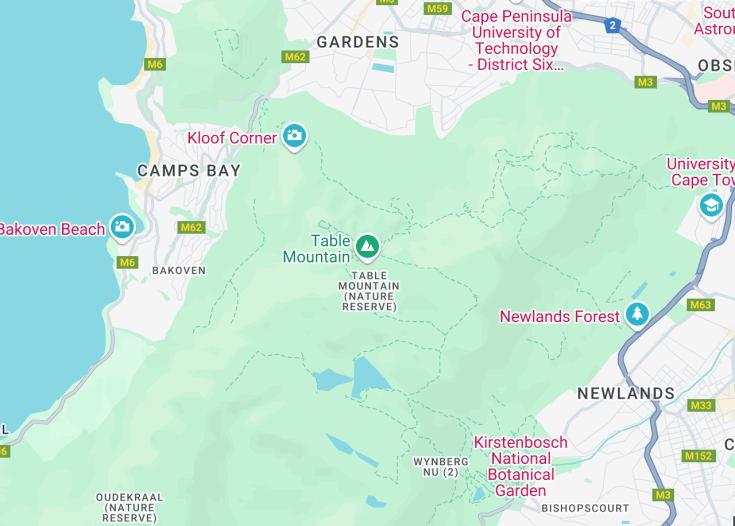Table Mountain National Park, a jewel in South Africa’s environmental crown, is celebrated not only for its iconic flat-topped mountain but also for its stunning biodiversity and panoramic vistas. Established in 1998, it spans from Signal Hill to Cape Point, covering approximately 221 square kilometers. Known for its rich, endemic flora, the park lies within the Cape Floristic Region, a UNESCO World Heritage site. It’s a sanctuary for numerous species, including the famous fynbos vegetation and the elusive Table Mountain ghost frog. The park’s landscape is marked by rugged cliffs, lush valleys, and serene beaches, making it a prime spot for outdoor activities like hiking, biking, and bird watching.
When visiting, always check the weather forecast as conditions on Table Mountain can change swiftly, potentially impacting visibility and safety.
Consider purchasing a Wild Card for extended access to all the park’s areas and trails, which can also provide discounts on some activities.
Table Mountain National Park: Nature Resplendent
Table Mountain National Park, located at the heart of Cape Town, South Africa, is a vital conservation area pivotal in preserving the unique biodiversity of the region. Distinguished by the iconic flat-topped Table Mountain, this park offers panoramic vistas of the bustling city and the sprawling Atlantic Ocean. It isn’t merely a visual spectacle; the park plays an essential role in protecting various ecosystems, from rocky shores to mountainous terrains, supporting a rich array of flora and fauna. Drawing adventurers and nature enthusiasts from all around the globe, it offers a variety of recreational activities ranging from hiking and biking to cable car rides showcasing awe-inspiring views. The mountain’s summit is easily accessible via the popular cableway, providing a unique opportunity to witness the spectacular landscape from above. For those passionate about wildlife and natural beauty, Table Mountain National Park serves as a perfect blend of adventure and tranquility, making it a must-visit destination on any South African travel itinerary.
Explore The Diversity of Flora and Fauna
Table Mountain National Park is not just about its classic views; it’s a sanctuary teeming with extraordinary biodiversity. Among its captivating attractions is the Cape Floral Kingdom, which is widely recognized for its unique and rich vegetation. Visitors are likely to encounter over 2,200 species of plants found nowhere else on the planet. Adventure seekers can delve into several hiking trails, such as the popular Platteklip Gorge route, or engage in more strenuous activities like rock climbing. For those interested in wildlife, the park is home to creatures such as the rare Cape Mountain Leopard, bontebok, and several species of lizards and snakes. Moreover, birdwatching enthusiasts will find a spectacular variety of birds, including the majestic Verreaux’s eagle. The variety of available activities makes the national park not just a scenic destination but a diverse habitat to explore and respect.
The Awe-Inspiring Kirstenbosch Botanical Gardens
Located on the eastern slopes of Table Mountain, Kirstenbosch National Botanical Garden is celebrated as one of the world’s most beautiful botanical gardens. Covering 528 hectares, it serves both as a stronghold of conservation and a place of exquisite beauty. The garden hosts a variety of themed gardens, including the Fragrance Garden, the Medicinal Garden, and the Protea Garden — home to South Africa’s national flower. One of the key highlights is the “Boomslang” canopy walkway that offers an immersive experience amidst the treetops, providing stunning views of the mountain and surrounding flora. Moreover, visitors can enjoy outdoor concerts and art exhibitions, making Kirstenbosch a dynamic and inspiring visit. This beautiful area encapsulates the spirit of Table Mountain National Park by combining the tranquility of nature with cultural activities.
Explore the wonders of Table Mountain National Park
Suitable for adventure seekers, nature enthusiasts, and families, Table Mountain National Park offers a diverse array of activities and breathtaking landscapes. From leisurely walks and challenging hikes to rich biodiversity and panoramic views, this destination provides an exceptional outdoor experience for all ages. Visitors can expect to encounter unique flora and fauna, engage in bird watching, or delve into historical sites scattered throughout the park. Whether you are travelling solo, with a partner, or as a group, the park caters to a broad spectrum of interests and fitness levels, making it an ideal outing for everyone.
Best times to visit Table Mountain National Park
Spring and autumn are optimal for visiting Table Mountain National Park due to mild weather, which enhances the hiking and sightseeing experience. During these seasons, the park’s natural beauty is at its peak, offering vibrant floral displays and comfortable temperatures.
Annual Flower Bloom
An especially great time to visit is during the annual flower bloom from late August to early October, when the park is adorned in a tapestry of colorful wildflowers, attracting photographers and nature enthusiasts from around the globe.
Accessibility and limitations
Understanding the accessibility and limitations at Table Mountain National Park is crucial for planning your visit efficiently.
Accessibility
Limitations
- Drone flying is prohibited.
- Open fires are restricted within the park boundaries.
- Pets are not allowed to ensure the safety of the wildlife.
Notes to visitors
- Wear suitable footwear for hiking.
- Bring water, especially in summer months.
- Be aware of weather changes; capes can be windy.
General informations
Here are some important details for your visit to Table Mountain National Park:
Location
Nearby landmarks include the scenic Chapman’s Peak Drive and the bustling V&A Waterfront, making it easily accessible and a must-visit destination in the region.
Address: Table Mountain National Park, Cape Town, South Africa
Opening hours
The park is open daily from 07:00 AM to 07:00 PM. It remains open on all public holidays, providing ample opportunity for visitors to explore its vast expanses.
How to reach Table Mountain National Park
Car
Driving to Table Mountain National Park offers scenic routes and control over your travel itinerary. Several parking areas are available near the main access points.
| Route | Distance | Travel time |
|---|---|---|
| From Cape Town City Center | 15 km | 25 minutes |
| From Cape Town International Airport | 20 km | 30 minutes |
Public Transport
Buses and shuttles run regularly from major points in the city to the park, offering a convenient alternative to driving, especially during peak tourist seasons.
Nearby Attractions
Exploring the surroundings of Table Mountain National Park adds more flavor to your visit:
- Robben Island Museum – 6 miles (9.7 km)
- Kirstenbosch National Botanical Garden – 3 miles (4.8 km)
- Cape of Good Hope – 30 miles (48.3 km)
Common questions
What are the key attractions in Table Mountain National Park?
- Cape Point: A spectacular viewpoint known for its dramatic sea cliffs and lighthouse.
- The Cape of Good Hope: Often mistaken as the southernmost point of Africa, it’s a historic and scenic area with rich maritime significance.
- Boulders Beach: Famous for its colony of African penguins, it’s a favorite for wildlife enthusiasts.
- Signal Hill and Lion’s Head: These provide stunning panoramic views of Cape Town and are popular spots for hiking and paragliding.
- Kirstenbosch Botanical Gardens: Known for its conservation of native flora, visitors can stroll through beautifully landscaped gardens and even catch a live concert in the summer months.
- Silvermine Nature Reserve: Offers hiking trails, picnicking spots, and breathtaking reservoir views.
These attractions offer a combination of natural beauty, wildlife, and historical context, making the park a comprehensive and engaging experience.
What wildlife can I expect to see in Table Mountain National Park?
- Baboons: Often seen around Cape Point, though they can be aggressive so it’s important to keep a safe distance.
- African Penguins: Primarily at Boulders Beach, these charming creatures are a major draw.
- Various antelope species: Including eland, bontebok, and klipspringer, commonly spotted in the quieter areas of the park.
- Porcupines, mongooses, and Cape foxes: Though more elusive, these animals can sometimes be seen during quieter times.
- Diverse birdlife: The park is a haven for bird watchers with numerous species like sunbirds, eagles, and others.
The park’s ecosystem supports a complex web of life adapted to its unique mountain and coastal environments. It’s a must-see for nature lovers looking to encounter South Africa’s wildlife up close.
Are there guided tours available in Table Mountain National Park?
- Hiking Tours: These are among the most popular, covering various parts of the park including the summit of Table Mountain and the Cape of Good Hope.
- Cultural and Historical Tours: Learn about the rich history of the Cape region, from early indigenous peoples to modern times.
- Ecological Tours: Focusing on biodiversity, these tours provide insights into the unique ecosystems and conservation efforts in the park.
- Bird-Watching Tours: Aimed at bird enthusiasts, these guided tours emphasize spotting and identifying local bird species.
Tour services are available from various providers, each offering different focuses and itineraries. It’s advisable to book in advance, especially during peak tourist seasons.
What hiking trails are available in Table Mountain National Park?
- Platteklip Gorge: The most direct route to the summit of Table Mountain, challenging but rewarding with spectacular views.
- Lion’s Head: Provides 360-degree views of Cape Town and is especially popular during full moon hikes.
- Pipe Track: Relatively easy and offers stunning views, suitable for casual hikers.
- Kirstenbosch Centenary Tree Canopy Walkway: Known as the “Boomslang” (tree snake), this walkway offers an elevated view of the gardens and its flora.
- Silvermine Nature Reserve: Features a range of trails and a reservoir perfect for a swim after a hot hike.
- Cape of Good Hope trails: Various routes offer views of rugged coastline, historic lighthouses, and possible whale sightings in season.
Each trail offers unique views and experiences, from challenging climbs to leisurely walks, ensuring there’s something for everyone.
What is the best time of year to visit Table Mountain National Park?
- Summer (November to February): This is peak tourist season with hot, dry weather ideal for hiking and beaches. However, it can be crowded, and early morning visits are recommended to avoid the heat.
- Winter (June to August): Cooler temperatures and occasional rain. The landscape is lush and green, and this season is great for photography. Remember to pack warm clothing and waterproof gear.
- Spring and Autumn: Transitional months (September to October and March to May) offer mild weather with fewer tourists. This is also a beautiful time for wildflowers, particularly in the Cape Point area.
Ultimately, the decision depends on what you want from your visit: vibrant summer activity, serene winter beauty, or the balanced conditions of shoulder seasons.
What conservation efforts are in place at Table Mountain National Park?
- Alien Vegetation Control: Efforts to remove non-native plant species that threaten the local flora.
- Fire Management: Controlled burns are conducted to prevent unmanageable natural fires and to foster a healthy ecological balance.
- Fauna & Flora Protection: Programs aimed at conserving endangered species like the Table Mountain ghost frog and the Cape leopard.
- Water Conservation Measures: These are critical in the Cape Town area, known for its water scarcity issues.
- Environmental Education: The park provides resources and guides to educate visitors on the importance of conservation and responsible tourism.
- Community Involvement: Working with local communities to ensure the benefits of conservation and tourism are shared.
These combined efforts ensure the park remains a sustainable destination for future generations.
Can I camp overnight in Table Mountain National Park?
- Orangekloof Tented Camp: Offers a luxury camping experience with amenities close to Hout Bay.
- Slangkop Tented Camp: Near Kommetjie, providing ocean views and beach access.
- Smitswinkel Tented Camp: Located just before the Cape of Good Hope, it’s ideal for those looking to explore the southern parts of the park.
These campsites are part of the Hoerikwaggo Trail accommodation options and require advance booking, particularly during peak seasons. Each camp provides basic facilities including hot showers, bedding, and communal kitchens, enhancing an eco-friendly, leave-no-trace camping experience.
Are there any safety concerns while visiting Table Mountain National Park?
- Weather Changes: The weather can be unpredictable and change rapidly, especially at higher altitudes. It’s important to be well-prepared with appropriate clothing and gear.
- Hiking Safety: Stick to marked trails, carry sufficient water, and notify someone of your plans. Consider a guide for unfamiliar or challenging routes.
- Wildlife Interactions: Maintain a respectful distance from all wildlife, particularly baboons which are known to be aggressive if provoked.
- Personal Security: Although the park is patrolled, petty crime can occur. Always keep valuables secure and be aware of your surroundings.
By adhering to these precautions, combined with common sense, your visit can remain both enjoyable and safe.

Is Table Mountain National Park worth visiting?
Table Mountain National Park is not just a tourist destination; it’s a remarkable encounter with nature. Standing at the top of Table Mountain provides a panoramic view of Cape Town that is both stunning and unforgettable. The park’s diverse ecology, featuring over 2,200 species of plants and numerous animals, makes it a haven for nature enthusiasts. Moreover, the range of activities including hiking, climbing, and a cable car ride, cater to different interests and fitness levels. The rich cultural significance and natural beauty of Table Mountain make it an essential experience for anyone visiting Cape Town. From leisurely strolls along the contour paths to adventurous scrambles up its steep faces, the park offers countless opportunities to engage with South Africa’s rugged landscapes. Its status as a New7Wonders of Nature only highlights its prestige as a world-class natural asset.









